|
|
|
Sort Order |
|
|
|
Items / Page
|
|
|
|
|
|
|
| Srl | Item |
| 1 |
ID:
176889
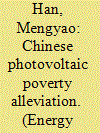

|
|
|
|
|
| Summary/Abstract |
As a part of an environmentally concerned development strategy, the photovoltaic poverty alleviation in China is adopted to lift households above the rural extreme poverty line by the end of 2020. With the detailed project-level data in 534 counties, 22 provinces, this systematic assessment on Chinese photovoltaic power projects identifies geographic distribution, economic benefits and emission mitigation for deployment distribution and policy implications. Overall, the photovoltaic installed capacity has reached 5213.37 MW, with the income generation of 7.41 billion CNY per year and the carbon emission mitigation of 5.98 million tons. From the results in this work, it is obvious that the GDP and household savings per capita in most counties and cities are lower than in those without photovoltaic poverty alleviation stations. As an essential strategy of generating income and mitigating emissions especially in countries well-endowed with sunlight, the deployment of photovoltaic power projects is consistent with sustainable development goals relating to global poverty eradication. With the assessments on the photovoltaic power stations, the initial implementation of photovoltaic poverty alleviation revealed a number of problems and solutions, which are practical for systematic deployment and policy implications of relevant photovoltaic power projects worldwide.
|
|
|
|
|
|
|
|
|
|
|
|
|
|
|
|
| 2 |
ID:
128523
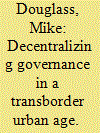

|
|
|
|
|
| Publication |
2013.
|
| Summary/Abstract |
The devolution of political power to local governments is taking new directions as cities begin to look beyond national borders to create economic synergies with city regions in other countries rather than continuing to look to linkages with their capital cities for economic benefits. In East Asia the search for transborder urban linkages comes at a time when secondary cities in higher income countries are confronting major social and economic transformations. These new trends include: the rise of China in the global economy, the turn toward neoliberal downsizing of government, demographic transitions toward declining, rapidly aging populations with a diminishing labour force compensated partly by the large-scale recruitment of foreign workers and foreign spouses. The combined result of the new dynamics is that just when political power is being devolved to the urban scale, the global trend of "shrinking cities" has reached them. The discussion focuses on recent initiatives of the local governments of Busan,OLYMPUS DIGITAL CAMERA South Korea, and Fukuoka, Japan, to build a "common living sphere" through transborder linkages to provide a culturally rich, people-centered alternative that contrasts with the high-technology industrial clusters being planned for them from their corporatized capital cities. In addition to economic issues, cities engaged in such transborder initiatives challenge the meaning of national borders and citizenship while also confronting new issues in accommodating the appearance of multicultural societies, which have all remained outside of mainstream discussions on decentralization.
|
|
|
|
|
|
|
|
|
|
|
|
|
|
|
|
| 3 |
ID:
160863
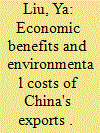

|
|
|
|
|
| Summary/Abstract |
This paper decomposes economic benefits (value‐added) and environmental costs (CO2) of exports according to their sources, and maps the global value network (GVN) and the global emissions network (GEN) for China's exports during 1995–2009 from national, sectoral and national–sectoral perspectives. A comparison is conducted between China and the USA. National GVN and GEN show that shares of value‐added and CO2 emissions from China in its GVN and GEN both decreased first then increased after 2006, while shares from the USA in its GVN and GEN generally decreased. Sectoral GVN and GEN show that among China's exports, “electrical and optical equipment” and “electricity, gas and water supply” were, respectively, the sectors that obtained the most value‐added and emitted the most CO2. National–sectoral GVN and GEN for China exhibited reciprocal and disassortative patterns, and in‐strengths and out‐strengths of GVN and GEN for China's exports were mainly captured by several domestic country–sector pairs.
|
|
|
|
|
|
|
|
|
|
|
|
|
|
|
|
| 4 |
ID:
132736


|
|
|
|
|
| Publication |
2014.
|
| Summary/Abstract |
Are preferential trade agreements (PTAs) in the Asia-Pacific region merely a political phenomenon with no economic basis, as some critics say? I challenge this interpretation; in this article I present an explanatory model based on intra-industry trade to indicate what economic interests should drive Japanese and South Korean PTAs with ASEAN partners, and derive specific predictions. An analysis of the actual tariff barrier elimination in the agreements suggests important, but highly specific, economic benefits. First, preference margins are substantively greater for intra-industry trade, and second, intra-industry trade is much less likely to be excluded from tariff reductions when imported into Japan or South Korea. This indicates that PTAs help firms specialize their production throughout the region, and provides an economic rationale for these agreements. A qualitative case study of the Japan-Malaysia PTA and a statistical analysis of tariff liberalization in the PTAs of Japan and South Korea with the ASEAN countries support this view.
|
|
|
|
|
|
|
|
|
|
|
|
|
|
|
|
| 5 |
ID:
128015


|
|
|
|
|
| Publication |
2014.
|
| Summary/Abstract |
Following the debate on the implications of international trade for global climate policy, this paper introduces the topic of the economic benefits from trade obtained by exporting countries in relation to the emissions generated in the production of exports. In 2008, 24% of global greenhouse gas (GHG) emissions and 20% of the employment around the world were linked to international trade. China "exported" 30% of emissions and hosted 37.5% of the jobs generated by trade worldwide. The European Union and the United States of America were the destination of 25% and 18.4% of the GHG emissions embodied in trade. The imports of these two regions contributed to the creation of 45% of the employment generated by international trade. This paper proposes the idea of including trade issues in international climate negotiations, taking into account not only the environmental burden generated by developed countries when displacing emissions to developing countries through their imports, but also the economic benefits of developing countries producing the goods exported to developed countries.
|
|
|
|
|
|
|
|
|
|
|
|
|
|
|
|
| 6 |
ID:
126958
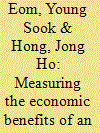

|
|
|
|
|
| Publication |
2013.
|
| Summary/Abstract |
This paper reports a first application of contingent valuation method to measure the value of information generated by earth science data from an environmental geostationary satellite payload called Geostationary Environmental Monitoring Satellite. The purpose of the space project is to improve the accuracy of air pollution information by enhancing air pollution monitoring and forecasting system coupled with conventional ground level monitoring stations located throughout South Korea.
Estimation results based on a survey data of 1000 households show that most explanatory variables including bid amounts and household income significantly influenced dichotomous choice contingent valuation responses with expected signs. When applied to the whole sample, mean willingness to pay reflecting both use and non-use values was stable at around $3.70 per year for the improvement of air quality information. Present values of total benefits over the lifetime period of the space satellite exceed the cost born by tax payers with a benefit-cost ratio of 2.77. The result of this study clearly suggests that contingent valuation method can be used as an alternative approach in measuring the value of information from a space-derived earth science project.
|
|
|
|
|
|
|
|
|
|
|
|
|
|
|
|
| 7 |
ID:
170101
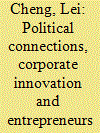

|
|
|
|
|
| Summary/Abstract |
In this paper, we attempt to reconcile the mixed effects of political connections on corporate innovation. Using the China Employer-Employee Survey (CEES), we find political connections contribute to innovative activities for those firms with innovative entrepreneurs but impedes innovative activities for those without innovative entrepreneurs. After solving the endogeneity problems and correcting the sample selection bias, the baseline results do not change much. Moreover, we find political connections can help firms obtain economic benefits such as tax preference and government subsidies which, however, are utilized by firms to increase fixed asset investment. But such positive effect of political connections on fixed asset investment greatly reduces when the firm's entrepreneur has a strong spirit of innovation. These results provide a reasonable explanation for the change in the direction of the effect of political connections on corporate innovation. This paper succeeds in reconciling the mixed effects of political connections on corporate innovation by taking the entrepreneur's innovative spirit into account.
|
|
|
|
|
|
|
|
|
|
|
|
|
|
|
|
| 8 |
ID:
133359


|
|
|
|
|
| Publication |
2014.
|
| Summary/Abstract |
Water thus extracted is not mineral water or sweet water but zero water or raw water in local lingo. It is treated through various kinds of purification processes distillation, ozonation ultraviolet light etc.
|
|
|
|
|
|
|
|
|
|
|
|
|
|
|
|
| 9 |
ID:
180091


|
|
|
|
|
| Summary/Abstract |
Canadian hydropower resources offer a potentially attractive option for meeting decarbonization targets in the US Northeast region, where there are ambitious climate goals and nearby hydro resources in Quebec. Existing transmission capacity is, however, a limiting factor in expanding hydropower imports to the region. To examine the value of expanding transmission capacity from Quebec to the Northeast, we employ an integrated top-down bottom-up modeling framework (USREP-EleMod). This research was part of an Energy Modeling Forum effort, EMF34, with a goal of better characterizing linkages in energy markets across North America. The scenarios we examine exogenously expand transmission capacity by 10, 30, and 50% above existing capacity into the US Northeast (New York/New England), finding the value to the economy of these expansions ranging from $.38-$.49 per kWh imported into New York, and $.30-$.33 per kWh imported into New England by 2050. The scenarios include economy-wide emissions goals these states have set for themselves. The carbon limits we imposed raise fuel prices more than electricity prices and as a result we found greater electrification in the US Northeast region from 2030 onward, a result that one would not see using just an electricity sector model, demonstrating a main hypothesis of EMF34, that models that looked at more integration across energy markets would give deeper insight than more narrowly focused models.
|
|
|
|
|
|
|
|
|
|
|
|
|
|
|
|
| 10 |
ID:
133358


|
|
|
|
|
| Publication |
2014.
|
| Summary/Abstract |
From major multinational corporations to medium - and small scale enterprises, the water bottling industry has been thriving consistently. This is surprising, considering that bottle water is a costly option and the privilege of choice, at a high price tag of, say, 150 Rupees for a 19 litter bottle.
|
|
|
|
|
|
|
|
|
|
|
|
|
|
|
|
| 11 |
ID:
132675


|
|
|
|
|
| Publication |
2014.
|
| Summary/Abstract |
Deregulation of the Danish retail electricity market nearly a decade ago has produced little consumer switching among suppliers or renegotiation of supplier service contracts. From an energy policy perspective, a certain amount of supplier switching is an important indicator of the success of market deregulation. This argues that poor relationship management and a lack of economic benefits are two critical barriers to consumer switching. Latent class analysis indicates that only 11.4% of consumers are non-switchers, whereas 41.1% can be considered potential switchers and approximately one-half (47.5%) can be considered apathetic consumers. We also discuss the managerial implications for both electricity suppliers and policy makers.
|
|
|
|
|
|
|
|
|
|
|
|
|
|
|
|
|
|
|
|
|